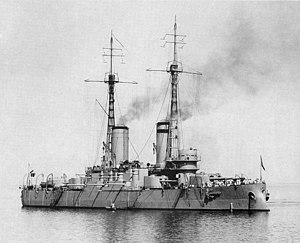 Andrei Pervozvanny in 1912
| |
| History | |
|---|---|
| Name | Andrei Pervozvanny |
| Namesake | Saint Andrew |
| Builder | Admiralty Shipyard, Saint Petersburg, Russia |
| Laid down | 11 May 1905 |
| Launched | 30 October 1906 |
| In service | 10 March 1911 |
| Acquired | November 1917 |
| Out of service | 1919 |
| Stricken | 21 November 1925 |
| Fate | Scrapped, 15 December 1923 |
| General characteristics as built | |
| Class and type | Andrei Pervozvanny-class predreadnought battleship |
| Displacement | |
| Length | 460 ft (140.2 m) (o/a) |
| Beam | 80 ft (24.4 m) |
| Draft | 27 ft (8.2 m) |
| Installed power |
|
| Propulsion | 2 shafts; 2 triple-expansion steam engines |
| Speed | 18.5 knots (34.3 km/h; 21.3 mph) |
| Range | 2,100 nmi (3,900 km; 2,400 mi) at 12 knots (22 km/h; 14 mph) |
| Complement | 956 |
| Armament |
|
| Armor |
|
Andrei Pervozvanny (Russian: Андрей Первозванный—St Andrew the First-Called) was an Andrei Pervozvanny-class predreadnought battleship built for the Imperial Russian Navy during the early-1900s. The ship's construction was greatly delayed by design changes as a result of the Russo-Japanese War and labor unrest after the 1905 Revolution, and she took nearly six years to build. Andrei Pervozvanny was not very active during World War I and her bored sailors joined the general mutiny of the Baltic Fleet in early 1917. She was used by the Bolsheviks to bombard the rebellious garrison of Fort Krasnaya Gorka in 1919 during the Russian Civil War and was torpedoed by British Coastal Motor Boats shortly afterwards, as part of the Allied intervention in the Russian Civil War. The ship was never fully repaired and was scrapped in 1923.